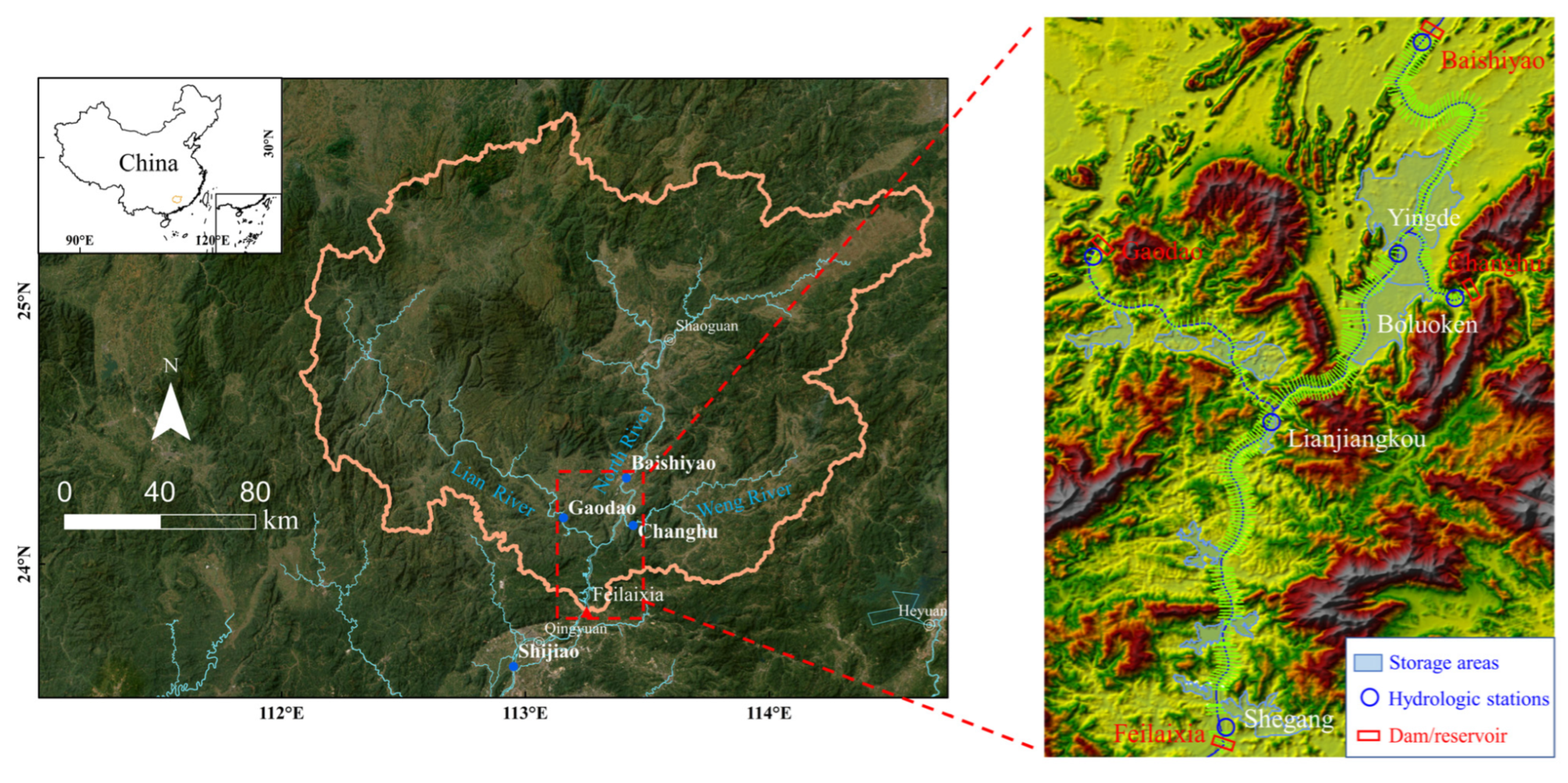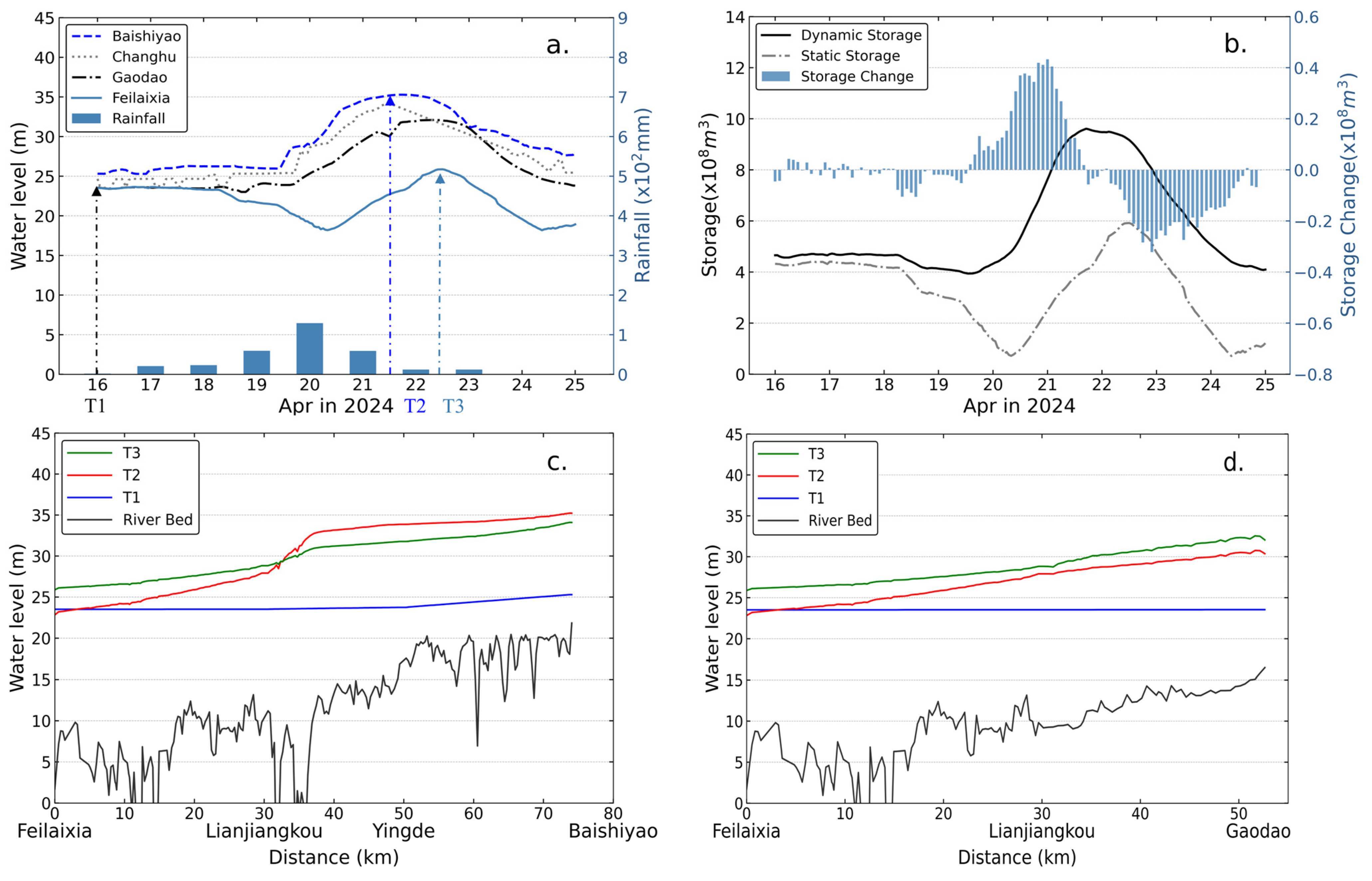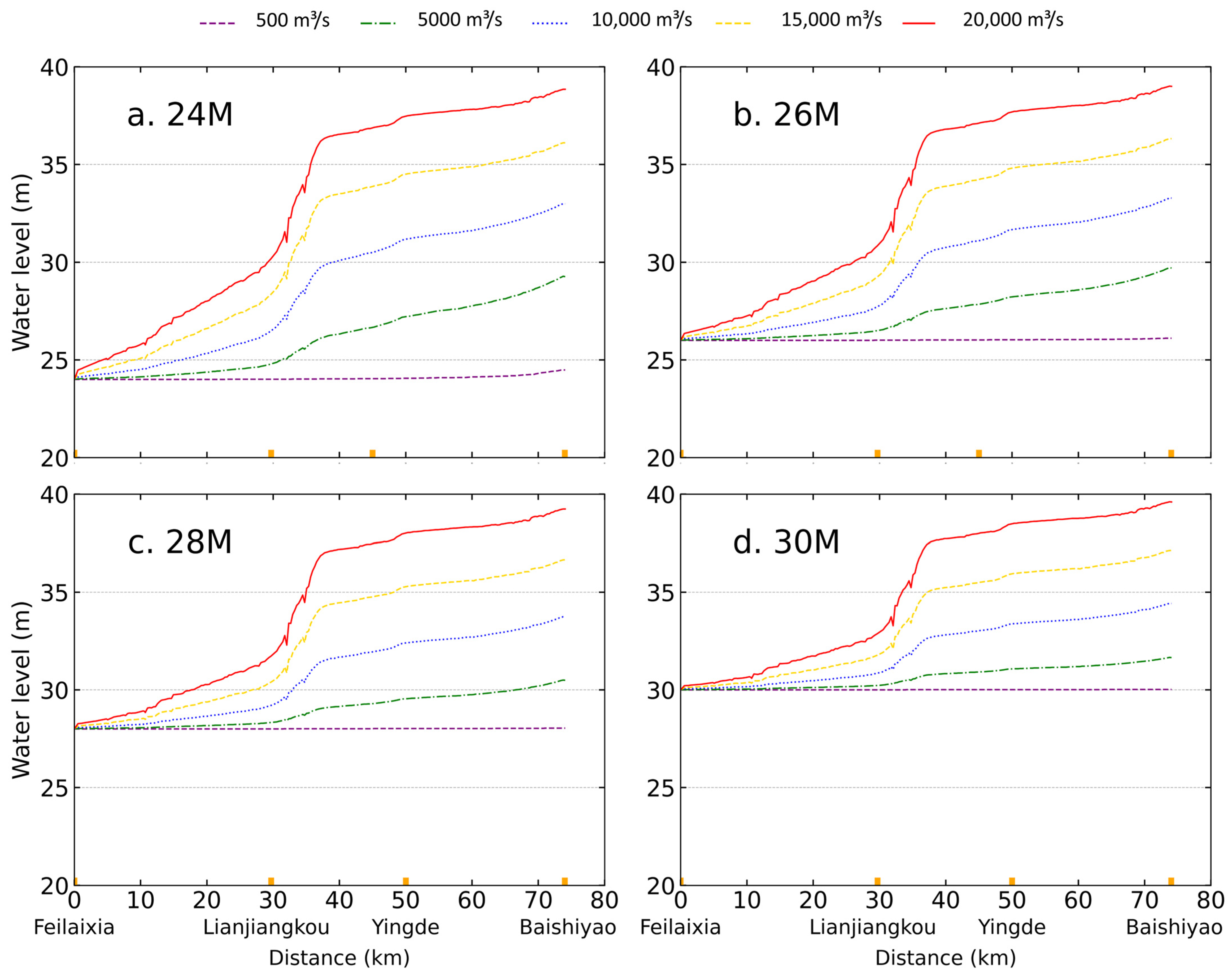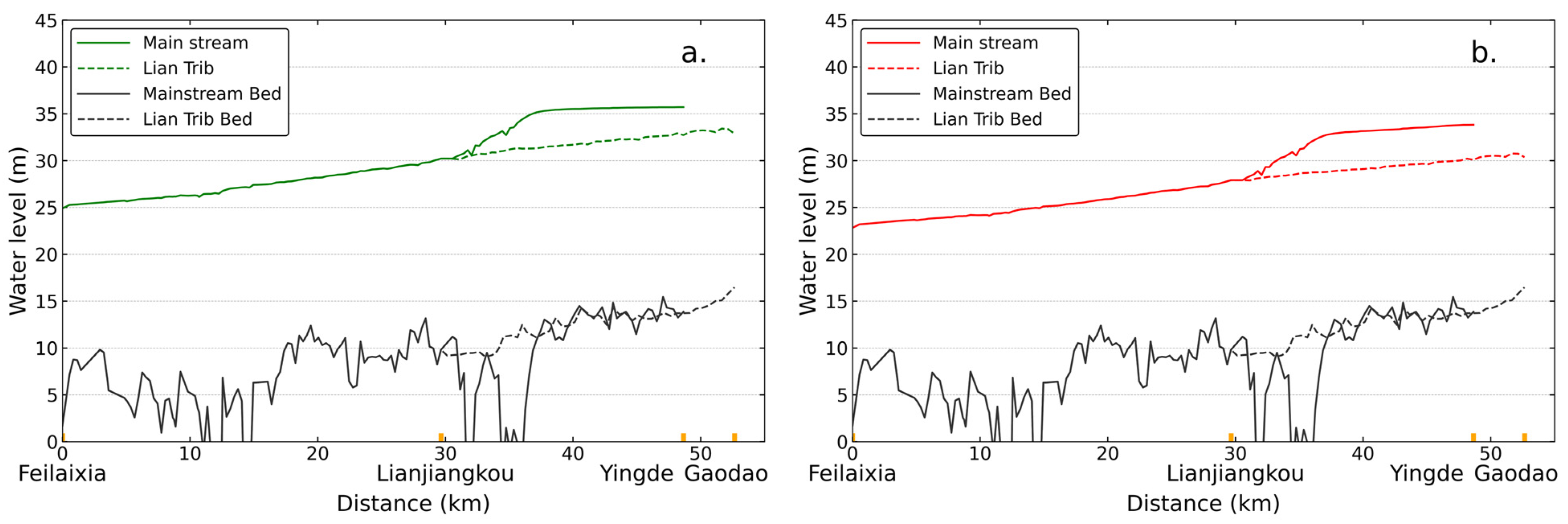Figure 1.
The North River Basin and the cross-section profiles of the Feilaixia Reservoir for setting up the 1D HEC-RAS model.
Figure 1.
The North River Basin and the cross-section profiles of the Feilaixia Reservoir for setting up the 1D HEC-RAS model.
Figure 2.
Illustration of the river cross-section profiles (green lines) for setting up the 1D HEC-RAS model and storage areas (SAs, blue lines) near the city of Yingde.
Figure 2.
Illustration of the river cross-section profiles (green lines) for setting up the 1D HEC-RAS model and storage areas (SAs, blue lines) near the city of Yingde.
Figure 3.
The hourly water levels at Yingde (a) and Lianjiangkou (b) during 17–25 June 2022 from model calibration and in situ observations.
Figure 3.
The hourly water levels at Yingde (a) and Lianjiangkou (b) during 17–25 June 2022 from model calibration and in situ observations.
Figure 4.
The hourly water levels at Yingde (a) and Lianjiangkou (b) during 16–25 April 2024 from model validation and in situ observations.
Figure 4.
The hourly water levels at Yingde (a) and Lianjiangkou (b) during 16–25 April 2024 from model validation and in situ observations.
Figure 5.
(a) Basin daily rainfall, hourly inflow from tributaries of the Weng River (Changhu) and Lian River (Gaodao), and water levels at Baishiyao in the upstream boundary and Feilaixia (in front of the dam) in the downstream boundary. (b) Twice-hourly storage changes, dynamic storage, and static storage. (c) Instantaneous water level profiles along the main stream of Feilaixia Reservoir and (d) along the Lian River tributary at three typical time, T1 6/17 00:00, T2 6/22 10:00, and T3 6/23 05:00, in June 2022.
Figure 5.
(a) Basin daily rainfall, hourly inflow from tributaries of the Weng River (Changhu) and Lian River (Gaodao), and water levels at Baishiyao in the upstream boundary and Feilaixia (in front of the dam) in the downstream boundary. (b) Twice-hourly storage changes, dynamic storage, and static storage. (c) Instantaneous water level profiles along the main stream of Feilaixia Reservoir and (d) along the Lian River tributary at three typical time, T1 6/17 00:00, T2 6/22 10:00, and T3 6/23 05:00, in June 2022.
Figure 6.
(a) Basin daily rainfall and hourly water levels in the upstream boundary at Baishiyao, Changhu, and Gaodao and in the downstream boundary at Feilaixia in front of the dam. (b) Twice-hourly storage changes, dynamic storage, and static storage. (c) Instantaneous water level profiles along the main stream of the Feilaixia Reservoir and (d) along the Lian River tributary at three typical time, T1 4/16 00:00, T2 4/21 13:00, and T3 4/22 12:00, in April 2024.
Figure 6.
(a) Basin daily rainfall and hourly water levels in the upstream boundary at Baishiyao, Changhu, and Gaodao and in the downstream boundary at Feilaixia in front of the dam. (b) Twice-hourly storage changes, dynamic storage, and static storage. (c) Instantaneous water level profiles along the main stream of the Feilaixia Reservoir and (d) along the Lian River tributary at three typical time, T1 4/16 00:00, T2 4/21 13:00, and T3 4/22 12:00, in April 2024.
Figure 7.
Simulated water level profiles along the Feilaixia Reservoir with five steady inflows and four constant water levels in front of the dam: (a) 24 m, (b) 26 m, (c) 28 m, and (d) 30 m.
Figure 7.
Simulated water level profiles along the Feilaixia Reservoir with five steady inflows and four constant water levels in front of the dam: (a) 24 m, (b) 26 m, (c) 28 m, and (d) 30 m.
Figure 8.
Simulation of the water surface elevation and inundation areas near the city of Yingde at a water level of 30 m in front of the dam and inflows of (a) 15,000 m3/s and (b) 20,000 m3/s.
Figure 8.
Simulation of the water surface elevation and inundation areas near the city of Yingde at a water level of 30 m in front of the dam and inflows of (a) 15,000 m3/s and (b) 20,000 m3/s.
Figure 9.
The simulated water level profiles along the Feilaixia Reservoir at four water levels in front of the dam and with four constant steady inflows: (a) 5000 m3/s, (b) 10,000 m3/s, (c) 15,000 m3/s, and (d) 20,000 m3/s. The triangles are the levee heights for the temporary flood storage areas of Shegang, Lianjiangkou, Boluoken, and Yingde.
Figure 9.
The simulated water level profiles along the Feilaixia Reservoir at four water levels in front of the dam and with four constant steady inflows: (a) 5000 m3/s, (b) 10,000 m3/s, (c) 15,000 m3/s, and (d) 20,000 m3/s. The triangles are the levee heights for the temporary flood storage areas of Shegang, Lianjiangkou, Boluoken, and Yingde.
Figure 10.
Comparison of simulated water level processes at Yingde (YD), Lianjiangkou (LJK), and Feilaixia (FLX) Dam under reservoir regulation and natural river in (a) June 2022 and (b) April 2024.
Figure 10.
Comparison of simulated water level processes at Yingde (YD), Lianjiangkou (LJK), and Feilaixia (FLX) Dam under reservoir regulation and natural river in (a) June 2022 and (b) April 2024.
Figure 11.
(a) Instant water level profiles along the main stream of Feilaixia Reservoir and the Lian River tributary at T2 6/22 10:00 and (b) T2 4/21 13:00. The orange labels are the location of the three water level sites.
Figure 11.
(a) Instant water level profiles along the main stream of Feilaixia Reservoir and the Lian River tributary at T2 6/22 10:00 and (b) T2 4/21 13:00. The orange labels are the location of the three water level sites.
Table 1.
The data sources and descriptions used in this study.
Table 1.
The data sources and descriptions used in this study.
| Item | Description | Source | Note |
|---|
| DEM | Resolution: 30 m | The Copernicus Digital Elevation Model (COP-DEM) released by the European Space Agency (ESA) | The geoid is EGM2008 |
| Levee | Precision: 0.01 m | Qingyuan Hydrology Bureau | - |
| Bathymetry | Precision: 0.1 m; Grid size: 5 m | The Pearl River Hydraulic Research Institute and Qingyuan Hydrology Bureau | Surveyed in 2020 and 2022 |
| Water level and flow | Hourly observations Precision: 0.01 m | Flood situation announcement system of Guangdong Provincial Water Resources Department (https://slt.gd.gov.cn/) | During flood events in 2022 and 2024. |
| Precipitation | Hourly observations Precision: 0.1 mm | Flood situation announcement system of Guangdong Provincial Water Resources Department (https://slt.gd.gov.cn/) | For flood events in 2022 and 2024. |
Table 2.
Water levels in front of the dam and reservoir inflow for seven return periods.
Table 2.
Water levels in front of the dam and reservoir inflow for seven return periods.
| Parameters | Return Periods (1: n Year) |
|---|
| 5 | 10 | 20 | 50 | 100 | 200 | 300 |
|---|
| Water level (m) | 24 | 24 | 24 | 25.17 | 28.65 | 30.81 | 31.17 |
| Inflow (m3/s) | 11,944 | 13,691 | 15,246 | 17,118 | 18,439 | 19,701 | 20,436 |
Table 3.
Scenario simulations for assumed reservoir inflow and water levels in front of the dam.
Table 3.
Scenario simulations for assumed reservoir inflow and water levels in front of the dam.
| Parameters | Water Level (m)/Flow (m3/s) |
|---|
| Water level (m) | 24 | 26 | 28 | 30 | - |
| Reservoir inflow | 500 | 5000 | 10,000 | 15,000 | 20,000 |
| North River/Baishiyao | 250 | 2500 | 5000 | 7500 | 10,000 |
| Weng River/Changhu | 100 | 1000 | 2000 | 3000 | 4000 |
| Lian River/Gaodao | 150 | 1500 | 3000 | 4500 | 6000 |
Table 4.
Instant inflow, outflow, simulated dynamic storage (S), static storage (S), and water levels (W.L.) along the main stream of the Feilaixia Reservoir at three typical time in June 2022. T1: before flood, T2: peak water levels at Yingde (YD), and T3: peak water levels at Feilaixia Dam (FLX). BSY: Baishiyao.
Table 4.
Instant inflow, outflow, simulated dynamic storage (S), static storage (S), and water levels (W.L.) along the main stream of the Feilaixia Reservoir at three typical time in June 2022. T1: before flood, T2: peak water levels at Yingde (YD), and T3: peak water levels at Feilaixia Dam (FLX). BSY: Baishiyao.
| Date and Time | W.L. at FLX (m) | W.L. at YD (m) | W.L. at BSY (m) | Inflow (m3/s) | Outflow (m3/s) | Dynamic S. (108 m3) | Static S. (108 m3) |
|---|
| T1 6/17 00:00 | 18.49 | 25.15 | 28.47 | 5290 | 5970 | 3.90 | 0.92 |
| T2 6/22 10:00 | 24.90 | 35.71 | 37.49 | 21,300 | 19,810 | 11.81 | 5.26 |
| Accumulated water change during 17–22 June (108 m3) | 62.98 | 55.22 | 7.91 | 4.34 |
| T3 6/23 05:00 | 26.82 | 34.09 | 35.22 | 15,580 | 17,860 | 11.19 | 6.56 |
| Accumulated water change during 22–23 June (108 m3) | 12.85 | 13.52 | −0.62 | 1.30 |
| Accumulated water change during 17–25 June (108 m3) | 92.21 | 90.83 | / | / |
Table 5.
Instant inflow at Gaodao (GD) and water levels (W.L.) along the Lian River tributary of the Feilaixia Reservoir at three typical time in June 2022. T1: before flood, T2: peak water levels at Yingde (YD), and T3: peak water levels at Feilaixia Dam (FLX). LJK: Lianjiangkou.
Table 5.
Instant inflow at Gaodao (GD) and water levels (W.L.) along the Lian River tributary of the Feilaixia Reservoir at three typical time in June 2022. T1: before flood, T2: peak water levels at Yingde (YD), and T3: peak water levels at Feilaixia Dam (FLX). LJK: Lianjiangkou.
| Date and Time | W.L. at FLX (m) | W.L. at LJK (m) | W.L. at GD (m) | Inflow at GD (m3/s) |
|---|
| T1 6/17 00:00 | 18.49 | 21.12 | 24.59 | 1700 |
| T2 6/22 10:00 | 24.90 | 30.10 | 32.89 | 8280 |
| Accumulated water change during 17–22 June (108 m3) | 20.59 |
| T3 6/23 05:00 | 26.82 | 30.19 | 33.15 | 8450 |
| Accumulated water change during 22–23 June (108 m3) | 5.79 |
| Accumulated water change during 17– 25 June (108 m3) | 35.73 |
Table 6.
Instant inflow, outflow, simulated dynamic storage (S), static storage (S), and water levels (W.L.) along the main stream of the Feilaixia Reservoir at three typical time in April 2024. T1: before flood, T2: peak water levels at Yingde (YD), and T3: peak water levels at Feilaixia Dam (FLX). BSY: Baishiyao.
Table 6.
Instant inflow, outflow, simulated dynamic storage (S), static storage (S), and water levels (W.L.) along the main stream of the Feilaixia Reservoir at three typical time in April 2024. T1: before flood, T2: peak water levels at Yingde (YD), and T3: peak water levels at Feilaixia Dam (FLX). BSY: Baishiyao.
| Date and Time | W.L. at FLX (m) | W.L. at YD (m) | W.L. at BSY (m) | Inflow (m3/s) | Outflow (m3/s) | Dynamic S. (108 m3) | Static S. (108 m3) |
|---|
| T1 4/16 00:00 | 23.51 | 23.73 | 25.31 | 450 | 410 | 4.65 | 4.32 |
| T2 4/21 13:00 | 22.82 | 33.71 | 35.22 | 16,970 | 15,100 | 9.50 | 3.85 |
| Accumulated water change during 17–22 April (108 m3) | 26.16 | 21.38 | 4.85 | −0.47 |
| T3 4/22 12:00 | 25.87 | 32.89 | 34.09 | 12,980 | 14,670 | 9.28 | 5.92 |
| Accumulated water change during 22–23 April (108 m3) | 12.48 | 12.75 | −0.22 | 2.07 |
| Accumulated water change during 17–25 April (108 m3) | 53.97 | 54.53 | / | / |
Table 7.
Instant inflow at Gaodao (GD), outflow, and water levels (W.L.) along the Lian River tributary at three typical time in April 2024. T1: before flood, T2: peak water levels at Yingde (YD), and T3: peak water level at Feilaixia dam (FLX). LJK: Lianjiangkou.
Table 7.
Instant inflow at Gaodao (GD), outflow, and water levels (W.L.) along the Lian River tributary at three typical time in April 2024. T1: before flood, T2: peak water levels at Yingde (YD), and T3: peak water level at Feilaixia dam (FLX). LJK: Lianjiangkou.
| Date and Time | W.L. at FLX (m) | W.L. at LJK (m) | W.L. at GD (m) | Inflow at GD (m3/s) |
|---|
| T1 4/16 00:00 | 23.51 | 23.52 | 23.54 | 50 |
| T2 4/21 13:00 | 22.82 | 28.05 | 30.37 | 6070 |
| Accumulated water change during 17–22 April (108 m3) | 7.62 |
| T3 4/22 12:00 | 25.87 | 29.06 | 32.05 | 7500 |
| Accumulated water change during 22–23 April (108 m3) | 6.24 |
| Accumulated water change during 17–25 April (108 m3) | 21.45 |
Table 8.
Variations in wedge storage and static storage (108 m3) at four constant water levels in front of the dam and four steady inflows.
Table 8.
Variations in wedge storage and static storage (108 m3) at four constant water levels in front of the dam and four steady inflows.
| Water Level (m) | Static Storage (108 m3) | Wedge Storage (108 m3) Under Four Inflows (m3/s) |
|---|
| 5000 | 10,000 | 15,000 | 20,000 |
|---|
| 24 | 4.76 | 0.89 (19%) | 2.54 (53%) | 4.58 (96%) | 9.49 (199%) |
| 26 | 5.92 | 0.67 (11%) | 2.23 (38%) | 4.11 (69%) | 9.03 (152%) |
| 28 | 7.26 | 0.58 (8%) | 1.94 (27%) | 4.60 (63%) | 8.67 (119%) |
| 30 | 8.81 | 0.48 (5%) | 1.77 (20%) | 4.28 (49%) | 8.84 (100%) |
Table 9.
Simulated water levels at the flood storage detention zones and the designed levee heights.
Table 9.
Simulated water levels at the flood storage detention zones and the designed levee heights.
| Inflow (m3/s) | Water level: Dam (m) | Shegang | Lianjiangkou | Boluoken | Yingde | Baishiyao |
|---|
| Levee Height (m) | 30.29 | 33.02 | 34.29 | 36.75 | - |
|---|
| 5000 | Natural river | 16.14 | 20.48 | 23.69 | 25.40 | 28.87 |
| 24 | 24.06 | 24.76 | 26.23 | 27.06 | 29.26 |
| 26 | 26.04 | 26.48 | 27.55 | 28.12 | 29.70 |
| 28 | 28.03 | 28.32 | 29.10 | 29.47 | 30.49 |
| 30 | 30.02 | 30.22 | 30.79 | 31.02 | 31.65 |
| 10,000 | Natural river | 19.40 | 23.90 | 28.67 | 30.08 | 32.55 |
| 24 | 24.25 | 26.41 | 29.93 | 30.99 | 32.99 |
| 26 | 26.16 | 27.67 | 30.62 | 31.50 | 33.28 |
| 28 | 28.11 | 29.17 | 31.56 | 32.26 | 33.74 |
| 30 | 30.08 | 30.83 | 32.73 | 33.26 | 34.42 |
| 15,000 | Natural river | 22.29 | 26.79 | 32.62 | 33.73 | 35.76 |
| 24 | 24.54 | 28.26 | 33.35 | 34.29 | 36.11 |
| 26 | 26.35 | 29.17 | 33.75 | 34.62 | 36.32 |
| 28 | 28.24 | 30.34 | 34.34 | 35.10 | 36.65 |
| 30 | 30.18 | 31.73 | 35.13 | 35.78 | 37.13 |
| 20,000 | Natural river | 24.85 | 29.33 | 35.96 | 36.87 | 38.65 |
| 24 | 24.92 | 30.06 | 36.41 | 37.25 | 38.85 |
| 26 | 26.61 | 30.74 | 36.67 | 37.47 | 39.00 |
| 28 | 28.43 | 31.65 | 37.06 | 37.81 | 39.24 |
| 30 | 30.31 | 32.81 | 37.62 | 38.29 | 39.60 |
Table 10.
Comparison of peak flood stages in reservoir regulation and natural river at Feilaixia (FLX), Lianjiangkou (LJK), and Yingde (YD) under reservoir regulation and natural river in June 2022 and April 2024.
Table 10.
Comparison of peak flood stages in reservoir regulation and natural river at Feilaixia (FLX), Lianjiangkou (LJK), and Yingde (YD) under reservoir regulation and natural river in June 2022 and April 2024.
| Date | Stations | Peak Flood Stages in Reservoir (m) | Peak Flood Stages in Natural River (m) | Stage Difference (m) |
|---|
| June 2022 | Feilaixia | 26.82 | 23.62 | 3.20 |
| Lianjiangkou | 30.37 | 29.23 | 1.14 |
| Yingde | 35.71 | 35.49 | 0.22 |
| April 2024 | Feilaixia | 25.87 | 21.89 | 3.98 |
| Lianjiangkou | 28.78 | 27.66 | 1.12 |
| Yingde | 33.71 | 33.70 | 0.01 |



















